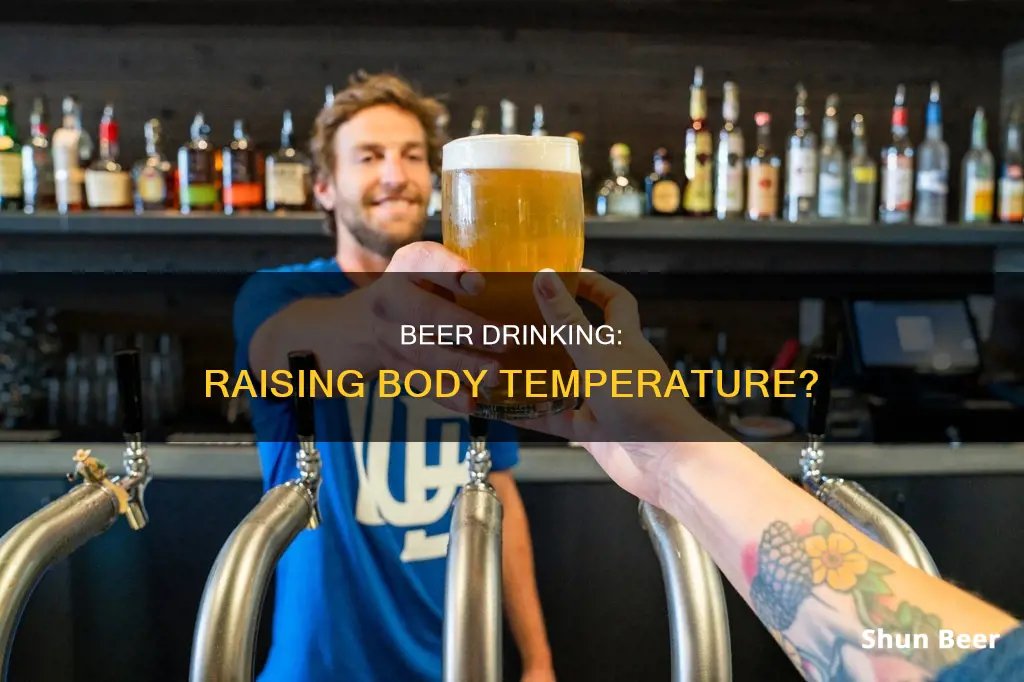
Alcohol consumption is often associated with flushed cheeks and a warm, fuzzy feeling. This is caused by vasodilation, or the widening of blood vessels, which lead to increased blood flow to the skin, giving you that warm sensation. However, contrary to popular belief, drinking alcohol does not actually raise your body temperature. In fact, it has the opposite effect, causing a drop in core body temperature. This is because the heat generated by the liver during alcohol metabolism and the increased blood flow to the skin lead to greater heat loss from the body's core. While this may seem harmless, it can be dangerous in cold environments, as it interferes with the body's natural ability to regulate temperature and can lead to hypothermia.
| Characteristics | Values |
|---|---|
| Does drinking beer raise your body temperature? | No, it creates the illusion of warmth by redistributing heat from your core to your skin. |
| Why does it feel warmer after drinking beer? | Alcohol is a vasodilator, which means it widens and relaxes your blood vessels, increasing blood flow to the skin and making you feel warm. |
| Why is drinking in cold weather dangerous? | Alcohol impairs your body's ability to regulate temperature, making you more susceptible to hypothermia. |
| What are the dangers of drinking alcohol in cold weather? | Serious complications can arise, including hypothermia and alcohol poisoning. |
| How to drink alcohol safely? | Follow guidelines by the UK Department of Health: limit to 14 units a week, pace drinking over 3+ days, and avoid alcohol if pregnant. |
What You'll Learn

Alcohol causes vasodilation, which increases skin temperature
Alcohol is a natural vasodilator. The consumption of alcohol causes vasodilation, or the widening of blood vessels, which is one of the reasons you may feel warm, sweat, or experience flushed skin. This occurs because alcohol causes the blood vessels in your skin to dilate, drawing blood away from your core and towards your skin's surface.
Vasodilation is a normal process that happens in your body without you even realizing it. It is triggered by low oxygen levels, a decrease in available nutrients, and increases in temperature. It increases blood flow and lowers blood pressure. Vasodilation can be caused by certain foods and drinks, medications, and can also be a symptom of certain diseases.
Vasodilation can be beneficial in some cases, such as in the treatment of high blood pressure and related cardiovascular conditions. However, it can also contribute to certain health issues, including low blood pressure and several chronic inflammatory conditions.
While alcohol may create the sensation of warmth, it is important to note that it does not actually raise your body temperature. Instead, it redistributes heat by drawing blood to the periphery of your body, giving you the feeling of being warm. This can be dangerous, as it interferes with your body's natural ability to regulate temperature and protect you from hypothermia.
Additionally, the sensation of warmth caused by alcohol-induced vasodilation can lead to sweating, which is another mechanism the body uses to lower its temperature through evaporation. This further contributes to the potential risk of hypothermia, especially in cold environments.
Beer and Headaches: Is There a Link?
You may want to see also

Alcohol affects thermoregulation, which can lead to hypothermia
Alcohol does affect thermoregulation and can lead to hypothermia. When you drink alcohol, it impacts the mechanisms your body uses to regulate its temperature, either by warming up or cooling down. This is because alcohol acts as a vasodilator, widening and relaxing your blood vessels, which increases blood flow to your skin and makes you feel warm. However, this is just an illusion as your body temperature is actually dropping.
The warm feeling after drinking alcohol is caused by the alcohol redistributing heat from your core to your skin. This shift in blood supply makes you feel warmer, but it is causing you to lose heat. While this may not be an issue in a warm environment, it can be dangerous in cold settings. In very cold temperatures, the body's natural response to constrict blood vessels to direct blood to vital organs is overridden by the alcohol-induced vasodilation. This can lead to a dangerous loss of body heat and, in extreme cases, hypothermia.
The combination of alcohol and cold weather can be dangerous and even lethal. Alcohol impairs the body's ability to regulate its temperature, and the cold can further lower body temperature. This is especially true for those who are homeless and exposed to extremely low temperatures, as they are at a higher risk of developing hypothermia.
The effects of alcohol on thermoregulation can also be influenced by various factors such as the quantity of alcohol consumed, the severity of the cold, the individual's body composition, and their nutritional state. Additionally, some people are more susceptible to flushed cheeks and redness when drinking due to a genetic deficiency of an enzyme that helps the liver break down alcohol.
It is important to be aware of the risks associated with alcohol consumption, especially when in cold environments, to avoid alcohol-induced bad decisions and to drink responsibly to minimise the potential health risks.
Beer Overload: When Does Enjoyment Become Excess?
You may want to see also

Alcohol is metabolised by enzymes in the liver
Alcohol is eliminated from the body by various metabolic mechanisms, primarily enzymes. The enzymes involved are aldehyde dehydrogenase (ALDH), alcohol dehydrogenase (ADH), cytochrome P450 (CYP2E1), and catalase. These enzymes metabolise alcohol through both oxidative and non-oxidative pathways.
The oxidative pathways involve the addition of oxygen or the removal of hydrogen through pathways involving ADH, CYP2E1, and catalase enzymes. ADH, present in the fluid of the cell (cytosol), converts alcohol (ethanol) to acetaldehyde. This reaction involves an intermediate carrier of electrons, nicotinamide adenine dinucleotide (NAD), which is reduced by two electrons to form NADH. As a result, alcohol oxidation generates a highly reduced cytosolic environment in liver cells (hepatocytes). This leaves the liver cells vulnerable to damage from the by-products of ethanol metabolism, such as free radicals and acetaldehyde.
CYP2E1, predominantly found in the cell's microsomes, also plays an important role in metabolising ethanol to acetaldehyde at elevated ethanol concentrations. CYP2E1 is induced by chronic alcohol consumption and contributes to ethanol oxidation in the liver and other tissues, such as the brain. Additionally, CYP2E1-dependent ethanol oxidation may occur in tissues with low ADH activity. This process also produces reactive oxygen species (ROS), which increase the risk of tissue damage.
Another enzyme, catalase, located in cell bodies called peroxisomes, can oxidise ethanol in the presence of a hydrogen peroxide (H2O2)-generating system. While this is considered a minor pathway of alcohol oxidation, chronic alcohol consumption has been shown to increase H2O2 production and catalase activity in the liver.
The non-oxidative metabolism of alcohol is minimal but can have pathological and diagnostic relevance. Alcohol is non-oxidatively metabolised by at least two pathways, leading to the formation of fatty acid ethyl esters (FAEEs) and a type of lipid-containing phosphorus known as phosphatidyl ethanol. These products may have long-lasting effects and contribute to alcohol-induced tissue damage.
The relative contributions of these oxidative and non-oxidative pathways to overall alcohol metabolism are complex and interrelated. Inhibiting ethanol oxidation by compounds that inhibit ADH, CYP2E1, and catalase can increase non-oxidative metabolism and the production of FAEEs in the liver and pancreas.
Genetic variations in the enzymes involved in alcohol metabolism, such as ADH and ALDH, can influence a person's susceptibility to developing alcoholism and alcohol-related tissue damage. These genetic differences affect the activity of alcohol-and acetaldehyde-metabolising enzymes, impacting peak blood acetaldehyde levels and voluntary ethanol consumption.
In summary, alcohol is metabolised by enzymes in the liver and other tissues, primarily through oxidative pathways involving ADH, CYP2E1, and catalase. This process generates by-products such as acetaldehyde and ROS, which can cause tissue damage and increase the risk of various health issues. The non-oxidative metabolism of alcohol is minimal but can also have important pathological consequences.
The Perfect Night Out: Beer or Liquor First?
You may want to see also

Flushing and sweating increase heat loss from the body
Flushing and sweating are mechanisms of thermoregulation that increase heat loss from the body. When you drink alcohol, your body temperature control, or thermoregulation, is affected. Alcohol causes unusual thermoregulation activity as it influences the mechanisms your body uses to either warm you up or cool you down.
As a vasodilator, alcohol causes the blood vessels in your skin to dilate, redirecting blood from your core to your periphery. This increases skin temperature and makes you feel warm, which may seem like a perk, but it can be dangerous. Your body's natural tendencies, such as detecting cold, are meant to protect you from hypothermia. Usually, your blood vessels constrict in lower temperatures to direct blood to your vital organs, but alcohol reverses this process.
As your skin temperature rises due to vasodilation, you may begin to sweat. Sweating is the most powerful autonomic thermoeffector in humans. It is the only means of heat loss when the air temperature exceeds skin temperature. The evaporation of sweat provides the greatest potential for heat loss. The body produces sweat through the stimulation of eccrine glands, which are distributed across the body surface. The secretion of sweat onto the skin surface increases in proportion to the intensity of the thermal challenge, helping the body attain heat balance and maintain a stable internal body temperature.
In summary, flushing and sweating are thermoregulatory responses that increase heat loss from the body. Alcohol consumption triggers these responses by altering normal thermoregulation activity and causing vasodilation, ultimately leading to a higher skin temperature and sweating. While this may create a warm and toasty feeling, it can be deceptive as the body's core temperature is actually dropping, particularly in cold environments.
The Ancient Greeks' Love for Beer Explored
You may want to see also

Alcohol can cause hot flushes as a hangover symptom
Hot flushes are a common symptom of a hangover, along with sweating, which is listed by the Cleveland Clinic as one of the more common symptoms. The intensity of the hot flushes and sweating often depends on the amount of alcohol consumed.
The primary cause of hot flushes is the body's inability to metabolise alcohol effectively. Alcohol is broken down by the body into acetaldehyde, a toxic substance. Some people have a genetic variation that results in a deficiency of an enzyme responsible for further metabolising acetaldehyde. As a result, acetaldehyde accumulates in their bodies, leading to hot flushes.
Hot flushes after drinking alcohol can be a warning sign that the body is struggling to process acetaldehyde, which is associated with an increased risk of alcohol-related health problems, including certain cancers, liver disease, and other alcohol-related conditions.
If you experience any physical symptoms, such as hot flushes, after drinking alcohol, it is recommended to review your intake and consult a professional if you are concerned.
In addition to hot flushes, other physical symptoms that may occur during a hangover include a rapid heart rate, dizziness, nausea, high blood pressure, and a rapid heartbeat. These symptoms may indicate serious health conditions that require medical attention, especially if they are severe or frequent.
Understanding Beer Distribution: From Brewery to Glass
You may want to see also
Frequently asked questions
No, drinking beer does not raise your body temperature. While you may feel warm due to the vasodilator effect of alcohol, your body is actually losing heat and your core temperature is dropping.
Alcohol is a vasodilator, which means it widens and relaxes your blood vessels. This leads to increased blood flow to your skin, making you feel warm. However, this also causes you to lose heat from your body's core.
Drinking beer in cold weather can be dangerous as it interferes with your body's ability to regulate temperature. The alcohol makes your body think it's hot, so you may start sweating to cool down. In cold environments, this can lead to hypothermia.







